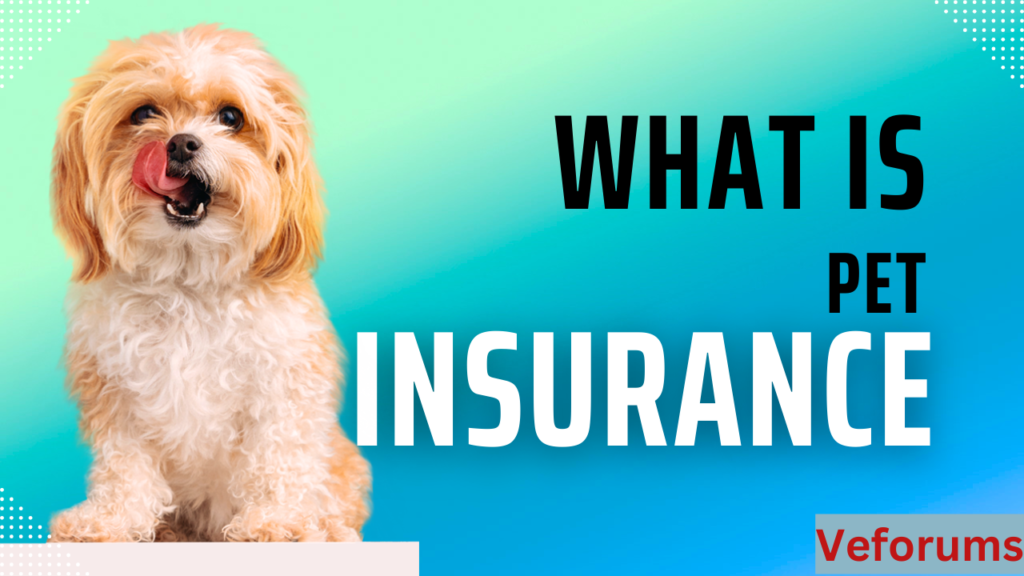What is Pet Insurance: A Comprehensive Guide to Coverage, Benefits, and Functionality

Pet insurance
The special and deep tie that exists between people and their dogs offers endless happiness and company. Pets are beloved parts of our families and should receive the best care possible to maintain their wellbeing. However, the unpredictability of diseases and accidents can present difficulties on both an emotional and financial level. Pet insurance emerges as a valuable solution, providing a financial safety net to address veterinary expenses. In this extensive guide, we will explore the intricate world of pet insurance, delving into its essence, the diverse coverage it offers, and the mechanics of how it works to safeguard the health of our beloved companions.
What is Pet Insurance?
Pet insurance is a specialized financial safeguard crafted to ease the monetary strain linked with veterinary care for domestic animals. In essence, it parallels the concept of health insurance for humans. This unique coverage acts as a vital safety net, stepping in to support pet owners when faced with unforeseen medical expenses. By doing so, it empowers owners to deliver essential care to their pets without the fear of compromising their own financial stability. Much like health insurance is indispensable for human well-being, pet insurance becomes a lifeline for ensuring that our beloved animal companions receive the necessary medical attention, fostering a relationship of trust and care between pets and their owners.
Types of Pet Insurance Plans
Accident-Only Coverage
This foundational pet insurance plan focuses exclusively on injuries resulting from accidents, including incidents such as broken bones, lacerations, or poisoning. It provides a straightforward and cost-effective option for pet owners seeking financial protection specifically for accidental injuries. While it serves as a valuable safety net for sudden and unexpected events, it’s important to note that this coverage does not extend to illnesses. Consequently, pet owners considering this plan should weigh the potential risks their pets face and the likelihood of accidents versus the broader health concerns associated with illnesses.
Accident and Illness Coverage
Representing a more comprehensive option, the accident and illness coverage plan goes beyond addressing only accidental injuries. It includes a wide spectrum of illnesses, covering diagnostics, medications, surgeries, and various treatments necessary to address diverse health issues. This inclusive approach provides pet owners with a more thorough financial safety net, encompassing both unforeseen accidents and the broader spectrum of illnesses that pets may encounter throughout their lives. This plan is particularly suitable for those seeking holistic coverage, ensuring that their pets receive comprehensive medical care, regardless of the nature of the health issue.
Wellness Plans
While less common than accident and illness coverage, some pet insurance providers offer wellness or preventive care plans. These specialized plans are designed to address routine veterinary visits, vaccinations, and preventive treatments. By promoting proactive pet care, wellness plans aim to prevent potential health issues before they arise. Although they may not cover accidents or illnesses to the same extent as comprehensive plans, wellness plans play a crucial role in maintaining the overall health and well-being of pets. Pet owners who prioritize preventive care and regular veterinary check-ups may find these plans beneficial in supporting their proactive approach to pet healthcare.
Preventive Care Add-ons
Certain pet insurance policies allow for additional preventive care add-ons, offering a customizable approach to coverage. Dental cleanings, flea and tick prevention, and other standard care procedures are a few examples of these add-ons. Pet owners may take proactive measures to protect their pets’ health and stop possible problems from arising by including preventive treatment in their insurance coverage. This modular approach allows for tailoring coverage to the specific needs of individual pets, providing a flexible and personalized insurance solution. Pet owners interested in a comprehensive and customized coverage approach may find preventive care add-ons to be a valuable addition to their insurance plan, ensuring a well-rounded protection strategy for their furry companions.
What Does Pet Insurance Cover?
Understanding the scope of coverage provided by pet insurance is pivotal in making informed decisions about the well-being of our pets. While specifics can vary among insurance providers, a general overview includes the following
Veterinary Fees
Examinations and Consultations
Pet insurance commonly covers routine check-ups and consultations with veterinarians, encouraging pet owners to prioritize regular health assessments for their animals. This coverage facilitates proactive healthcare, enabling early detection of potential issues and contributing to the overall well-being of pets. By incentivizing regular veterinary visits, this aspect of pet insurance promotes a preventive approach to healthcare, emphasizing the importance of routine examinations in maintaining pet health.
Diagnostic Tests
Coverage under pet insurance extends to diagnostic tests, encompassing essential procedures such as bloodwork, x-rays, MRIs, and ultrasounds. This inclusion proves invaluable in identifying underlying health issues, enabling veterinarians to make accurate diagnoses. The financial assistance provided by pet insurance for diagnostic tests ensures that pet owners can pursue necessary medical investigations without concerns about the associated costs, facilitating prompt and effective treatment for their pets.
Surgeries
In situations involving accidents, illnesses, or necessary procedures, pet insurance steps in to provide financial assistance for surgical expenses. This coverage is essential in ensuring that pets receive the vital surgical treatments they need, without placing an undue financial burden on pet owners. From routine surgeries to more complex procedures, this facet of pet insurance supports comprehensive medical care for pets, emphasizing the importance of addressing health issues that may require surgical intervention.
Specialist Consultations
Some pet insurance policies extend beyond basic coverage to include visits to specialists such as dermatologists, cardiologists, or oncologists. This reflects a more comprehensive approach to pet healthcare, acknowledging that certain health conditions may necessitate expertise beyond general veterinary care. By covering visits to specialists, pet insurance ensures that pets have access to specialized medical attention when needed, enhancing the overall quality of healthcare. This aspect of coverage is particularly beneficial for pets with specific health concerns that require the expertise of specialized practitioners, offering a well-rounded and adaptable approach to addressing diverse health needs.
Medications
Prescription Medications
Pet insurance commonly includes coverage for the cost of prescription medications, encompassing antibiotics, pain relievers, and other necessary drugs. This inclusion serves to alleviate the financial burden associated with ongoing treatment, ensuring that pet owners can afford the medications prescribed by veterinarians to address various health issues. By covering prescription medications, pet insurance enhances accessibility to essential drugs, promoting effective medical care for pets and facilitating the management of acute and chronic conditions.
Chronic Conditions
In instances where pets suffer from chronic conditions such as diabetes or arthritis, pet insurance may extend coverage to include long-term medications. This facet of coverage is invaluable in contributing to the management of persistent health issues, as it supports the ongoing treatment required to enhance the quality of life for pets with chronic ailments. By assisting with the financial aspects of long-term medication, pet insurance enables pet owners to provide consistent care for their animals, ensuring that pets receive the necessary treatments to manage chronic conditions effectively.
Alternative Therapies
Certain pet insurance policies go beyond conventional treatments and extend coverage to alternative therapies such as acupuncture or physical therapy. This reflects a progressive approach to pet healthcare, acknowledging the value of diverse treatment options. By covering alternative therapies, pet insurance provides pet owners with the flexibility to explore complementary and holistic approaches to address specific health issues in their pets. This inclusivity in coverage reflects the evolving landscape of veterinary care, recognizing the benefits of a comprehensive and personalized approach to pet health that goes beyond traditional medical interventions.
Emergency Care
Accidents and Injuries
Pet insurance routinely covers the costs associated with the treatment of injuries resulting from accidents. This includes fractures, wounds, and incidents of poisoning. The coverage ensures that pet owners can promptly seek and afford medical attention for their pets during emergencies, facilitating swift and effective care. By addressing the financial aspect of treating accidental injuries, pet insurance plays a crucial role in ensuring that pets receive immediate and necessary medical interventions in times of crisis.
Hospitalization
In instances where a pet’s health condition requires hospitalization, pet insurance may cover the associated costs. This facet of coverage supports comprehensive care for more severe health issues that necessitate extended stays in veterinary hospitals. By alleviating the financial burden of hospitalization, pet insurance ensures that pet owners can make informed decisions about their pets’ healthcare without the constraint of prohibitive costs, thus promoting the overall well-being of the animal.
Intensive Care
Some pet insurance policies go a step further by offering coverage for the expenses associated with intensive care. This includes addressing critical conditions that require specialized and constant attention. By providing financial support during emergencies and critical health situations, pet insurance with intensive care coverage ensures that pets receive the highest level of medical care, even in the most challenging circumstances. This aspect of coverage reinforces the role of pet insurance in safeguarding the health and life of pets, particularly in instances demanding advanced medical interventions and specialized care.
Chronic and Hereditary Conditions
Certain pet insurance plans extend their coverage beyond immediate concerns and include chronic and hereditary conditions. This proactive strategy guarantees financial support to pet owners for the management of continuous therapies needed for illnesses like hip dysplasia or diabetes. Pet insurance is a complete solution that promotes the long-term health and well-being of pets by covering chronic illnesses and inherited problems. In addition to meeting dogs’ urgent needs, this comprehensive coverage emphasizes the value of continued treatment for illnesses that could need it.
End-of-Life Care
Some pet insurance plans include end-of-life care as a caring measure that shows empathy and foresight and provides pet owners with comfort during emotionally trying moments. This coverage extends to services such as euthanasia, recognizing the difficult decisions that pet owners may face when their beloved companions reach the end of their lives. To further show how committed these plans are to ease the financial and emotional hardships associated with pet loss, the inclusion of cremation or burial charges is included. Pet insurance aims to give comfort and support to pet owners as they navigate the heartbreaking and unavoidable process of saying goodbye to their beloved animal companions. By providing financial support for end-of-life services, pet insurance not only acknowledges the depth of the human-animal link.
How Does Pet Insurance Work?
To make wise selections and get the most out of their policy, pet owners must comprehend the workings of pet insurance.
Premiums
For their pet insurance to remain in effect, owners must pay a monthly or yearly payment. One may choose a plan that fits their budget by taking into account many criteria such as the pet’s age, breed, location, and preferred coverage, as premiums vary accordingly.
Deductibles
Like health insurance for people, pet insurance plans frequently have a deductible, which is the first sum of money the policyholder has to pay out of pocket before the insurance kicks in. The rate is affected by the deductible option selected; often, cheaper premiums are associated with greater deductibles.
Reimbursement
When pet owners have to pay veterinarian bills, they file a claim with their insurance company and include receipts for the medical bills. Once approved expenditures have been incurred, the insurance company reimburses a portion of the costs, usually between 70% and 90%.
Maximum Limits
Pet insurance coverage might include lifetime or yearly maximum limitations to help control financial risks. The lifelong limit is the utmost amount the insurance will pay for the duration of the pet’s policy, whereas the annual limit is the highest amount it will pay in a policy year. Given the possible expenses of veterinary care, selecting coverage with suitable limitations is invaluable.
Waiting Periods
Most pet insurance policies incorporate waiting periods before coverage becomes effective. This precautionary measure prevents pet owners from obtaining insurance only when their pets are already sick or injured. Waiting periods vary for different types of coverage.
Exclusions
Pet insurance policies come with exclusions, and awareness of these exclusions is crucial for pet owners. Common exclusions may include pre-existing conditions, cosmetic procedures, and specific hereditary conditions related to certain breeds. Additionally, some policies may exclude particular treatments or alternative therapies.
Choosing the Right Pet Insurance
Selecting the appropriate pet insurance requires thoughtful consideration of various factors to ensure alignment with both the pet’s needs and the owner’s budget.
Research and Compare
Exploring Multiple Providers: A comprehensive understanding begins with researching different pet insurance providers. Comparing their coverage options, premiums, deductibles, and reimbursement rates is essential. Additionally, reading customer reviews provides valuable insights into the experiences of other pet owners with a particular insurer.
Policy Customization: Opting for insurers that allow customization of policies to fit a pet’s specific needs adds a layer of flexibility. Some insurers offer a range of coverage options and add-ons, allowing pet owners to tailor the policy to their pet’s unique health requirements.
Understand Policy Details
Reviewing Terms and Conditions: A thorough review of the terms and conditions of a policy is imperative to understanding its coverage, exclusions, and limitations. Awareness of waiting periods and any additional fees ensures clarity and prevents surprises during claims.
Assessing Customer Service: The quality of customer service provided by the insurance company is a crucial aspect of the decision-making process. Accessibility, responsiveness, and clarity in communication contribute to a positive overall experience for pet owners.
Consider Your Pet’s Needs
Pet’s Age and Breed: Tailoring coverage to a pet’s age, breed, and health history is essential. Certain breeds may be predisposed to specific conditions, and selecting a policy that addresses these considerations ensures comprehensive coverage.
Pre-existing Conditions: Understanding how the policy handles pre-existing conditions is crucial. While many insurers exclude pre-existing conditions, some policies offer coverage for curable pre-existing conditions after a waiting period.
Budgetary Considerations
Balancing Premiums vs. Out-of-Pocket: Costs Evaluating the budget to determine the affordability of monthly premiums and potential out-of-pocket expenses is a key consideration. Striking a balance between affordability and comprehensive coverage ensures financial stability.
Exploring Discounts and Deductibles: Inquiring about discounts offered by insurers, such as multi-pet discounts or discounts for enrolling a pet at a young age, can contribute to cost savings. Understanding how different deductible levels impact overall costs aids in making an informed decision.
The Evolving Landscape of Pet Insurance
As the demand for pet insurance grows, the industry undergoes continual evolution, introducing new trends and innovations to better cater to the diverse needs of pet owners.
Telemedicine and Virtual Consultations
In response to technological advancements, some pet insurance providers have embraced telemedicine options. This allows pet owners to engage in virtual consultations with veterinarians, offering convenience for minor health concerns or follow-up appointments.
Technology Integration
Advancements in technology play a pivotal role in shaping the landscape of pet insurance. Insurers are incorporating technology, such as mobile apps and online portals, to streamline the claims process. This not only enhances efficiency but also provides a more convenient experience for policyholders.
Expanding Coverage Options
Recognizing the diverse needs of pet owners, insurance providers are expanding their coverage options. This includes comprehensive coverage for alternative therapies, behavioral therapy, and even coverage for lost pets. The evolving landscape reflects the industry’s commitment to staying relevant and responsive to the changing demands of pet owners.
Common Misconceptions About Pet Insurance
Despite the numerous benefits of pet insurance, certain misconceptions persist, hindering some pet owners from making informed decisions about coverage.
Cost vs. Benefit Perception
One prevalent misconception is the belief that the cost of pet insurance outweighs the potential benefits. However, when considering the escalating costs of veterinary care, especially for unforeseen emergencies, the financial protection provided by pet insurance becomes invaluable. It serves as a proactive measure to mitigate significant financial burdens associated with unexpected health issues in pets.
Pre-existing Conditions
A common misunderstanding among pet owners is the assumption that pre-existing conditions are never covered by insurance. While this is generally true, some policies offer coverage for curable pre-existing conditions after a waiting period. Understanding the nuances of how pre-existing conditions are addressed allows pet owners to make more informed decisions.
Age Limitations
Another misconception revolves around the belief that pet insurance is primarily beneficial for young animals. In reality, older pets can still derive substantial benefits from coverage. Some insurers even offer policies specifically tailored to address the unique healthcare needs of senior pets, emphasizing the importance of insurance across all life stages.
All Breeds are the Same
An often overlooked aspect is the assumption that all breeds face identical health risks. In truth, different breeds may be predisposed to specific conditions, necessitating tailored coverage. Recognizing and considering a pet’s specific breed and potential genetic predispositions is crucial when selecting insurance to ensure comprehensive protection.
Conclusion
To sum up, pet insurance is an essential instrument for safeguarding the health and welfare of our beloved furry friends. To provide our pets the finest care possible and to fully appreciate the innumerable moments of joy and companionship they bring into our lives, as responsible pet guardians, getting pet insurance is a proactive move.
Pet insurance is becoming more and more important in the lives of pet owners, as seen by its changing landscape: increased coverage options and technology improvements. The bond between humans and their pets continues to deepen, and pet insurance serves as an indispensable resource, ensuring that our four-legged family members receive the care they deserve. This financial safety net allows us to cherish their presence for years to come, fostering a relationship that transcends the ordinary and celebrates the extraordinary connection between pets and their owners.
FAQ’s
Getting pet insurance is essential for pet owners because it acts as a safety net, financially supporting unexpected veterinary expenses. It ensures that pet owners can provide necessary medical care for their pets without worrying about the financial strain.
Pet insurance covers a variety of veterinary expenses, including exams, diagnostic tests, surgeries, specialist consultations, prescription medications, chronic conditions, alternative therapies, emergency care, and end-of-life services. The specifics may vary, so it’s crucial to review policy details to understand the coverage.
Typically, pet insurance excludes coverage for pre-existing conditions. However, some policies may cover curable pre-existing conditions after a waiting period. Understanding how a policy handles existing health conditions and disclosing them when obtaining coverage helps pet owners make informed decisions and avoid complications when filing claims.
No, pet insurance is beneficial for pets of all ages. While there are policies specifically for senior pets, insurance is valuable for addressing unexpected health issues at any life stage. Older pets can still benefit from coverage, and certain policies may cater to the unique healthcare needs of senior animals. The key is to choose a policy that considers the specific health needs of your pet, regardless of age.




1 thought on “What is Pet Insurance: A Comprehensive Guide to Coverage, Benefits, and Functionality”